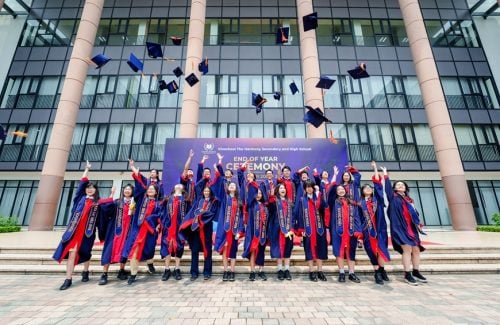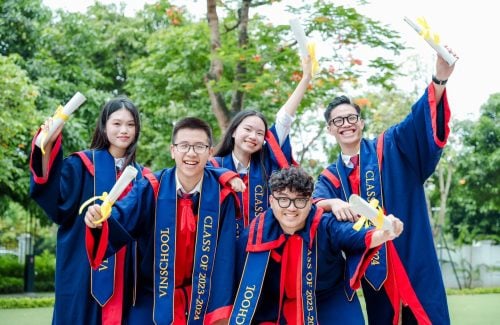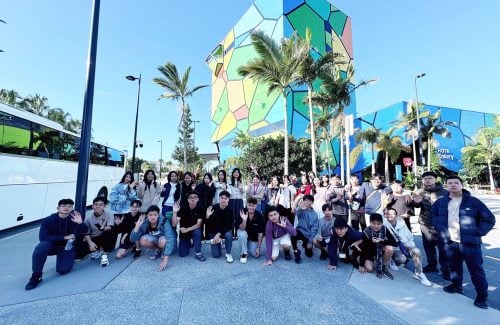Surprised at “smart” products made by secondary school students
Smart school lighting, devices that help blind people to avoid obstacles, automated sprinkler systems, smart trash bins... and many other products by Vinschool secondary school students surprised Judges and parents at the STEM Fair - 2019 Innovation Challenge. The contest has become a playground for students to showcase their interest in scientific research and help them to bring their knowledge out of the lab and apply it to the outside world.
A fun and practical scientific playground
This year’s contest attracted the participation of many science-lovers. 30 of the best projects reached the final round. At this Stem Fair, the judges and guests were surprised and delighted by the students’ projects. Hoang Nhat Duong (a 7th grader) joyously recounted how his “idea” for an automated sprinkler system/device came about: “Every time the family goes on vacation, my father worries that the plants at home will die due to lack of water. I wanted to do something so that he wouldn’t have to worry so much while we were away. That’s why I made this this”.

The advantage of the class’s product is remote controllability. With a Wi-Fi-connected smart phone, users can easily turn on/off their water pump. When the system starts, water is pumped up from a reservoir at the bottom of the potted plants. The device can water plants in drip or spray mode. Excess water from the plants flows back down to the reservoir. The filter system installed there treats the water ready for the next pump cycle.
To increase the nutrition in the water, Duong and his friends applied what they learned from their Biology lessons and decided to raise fish in the reservoir tank. This has not only made the final system much livelier and beautiful but the fish excrement is also rich in protein, and very beneficial for the plants’ development. The final product is a closed “ecosystem” and was a huge hit with the judges.
Nhat Duong is a familiar face at Vinschool’s science projects. He enthusiastically shared his passion: “We are better able to experience life through the Cambridge curriculum. We had to combine what we learned from 3 different subjects: Physics, Chemistry and Biology to realize this”.
Similarly, applying book knowledge to reality, Nguyen Nhu Dang Khanh, of class 7B1 at Vinschool Times City secondary school used basic knowledge from grade 6 & 7 Physics to create a smart trash disposal system that can automatically open and close its lid.

Dang Khanh has masterfully used knowledge learned from Sounds and lights in 7th grade in combination with ultrasonic sensors to create this product. When an obstacle is detected within 20cm of the sensors, the trash lid opens automatically and close 5 seconds later. The lid can be opened easily using the principles of “transforming electricity into motion” – a basic tenet of the transformation of energy we learned in the 6th grade” – Dang Khanh shared.
Beside science, Dang Khanh also used his programming knowledge to improve the product and made it smarter. The device is controlled using an Arduino UNO CPU, using ultra-sonic sensors to help with detection and a motor to open the lid. Dang Khanh expressed the wish to improve the product further: “Instead of using grid electricity as with the current model, I’d like to use solar energy in future models and make better use of this infinite renewable source of energy”.
Import and Localization of the Integrated Science Curriculum
Dr. Tran Ba Trinh, Director of the Center for Research and Development of Pedagogy, lecturer at the Physics department of the Hanoi Pedagogy University shared: “The students’ products have in part showed their ability to apply scientific knowledge learned in class to real life. This kind of teaching is very important to 21st century global citizens”.

Starting from the 2018 – 2019 academic year, Vinschool education has begun to localize the Cambridge Integrated Science curriculum and introduce it into the teaching curriculum for grades 1-8. This is the first international curriculum that was approved for import, localization and introduction to the classroom by the Ministry of Education and Training. It combines Biology, Chemistry and Physics into a single subject. The science curriculum in Vinschool prioritizes the development of critical thinking, problem-solving through inquiry-based teaching and scientific research-based teaching. Following its application a year ago, students are increasingly interested in activities that allow them to innovate and practice and has led to increases in scientific research projects being conducted.
The annual Innovation Challenge, held by Vinschool, is aimed at encouraging and nurturing students’ passion for science. While their products may not always be novel, they have importantly learned to apply their newly acquired knowledge in everyday life. This in turn shows them the meaning and usefulness of the knowledge they have acquired. Thanks to the Innovation Center – students now have a forum to realize their science projects, research, and create products. Vinschool is step-by-step creating a learning environment that closely links to real-life experiences, allowing students to practice even more, so that they can find their personal strengths, and pursue their dreams. This is all excellent preparation for the increasingly tough demands and standards of international integration.







